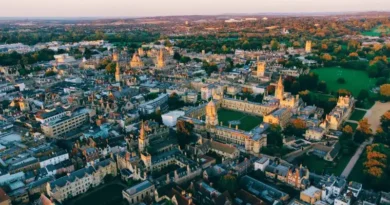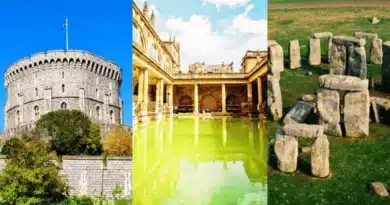Is Queen Elizabeth II Buried at Windsor Castle?
Yes, Queen Elizabeth II is buried at Windsor Castle. Following her state funeral at Westminster Abbey, she was laid to rest in the King George VI Memorial Chapel within St George’s Chapel at Windsor. She was interred alongside her husband, Prince Philip, and her parents, King George VI and the Queen Mother. Her sister, Princess Margaret, is also laid to rest there. The public can visit her final resting place by purchasing a ticket to Windsor Castle, which includes access to St George’s Chapel.
Takeaways
| Key Points |
|---|
| Queen Elizabeth II, the longest-reigning British monarch, was laid to rest at Windsor Castle in the King George VI Memorial Chapel, a small chapel within St George’s Chapel, following her state funeral at Westminster Abbey on 19 September 2022. |
| Her burial followed royal traditions, with a ceremonial procession from London to Windsor, a committal service at St George’s Chapel, and a final private ceremony attended by close family members, during which she was interred alongside her parents, King George VI and Queen Elizabeth the Queen Mother, her sister, Princess Margaret, and her husband, Prince Philip. |
| The King George VI Memorial Chapel was commissioned by Queen Elizabeth II in 1962 as a final resting place for her father and later became the burial site for several members of her immediate family. |
| St George’s Chapel, founded in 1348 and completed by Henry VIII, is a significant royal site, serving as the chapel of the Order of the Garter and the resting place of several monarchs, including Henry VIII and Charles I. |
| The public can visit the Queen’s burial site within Windsor Castle, which remains a historically significant royal residence and a place of personal connection for the Queen, who spent much of her life there. |
Introduction
Queen Elizabeth II, the longest-reigning British monarch, passed away on 8 September 2022 at the age of 96. Her funeral and burial were moments of national and international significance, watched by millions across the world. Many people wonder about her final resting place and whether she was buried at Windsor Castle. This article provides a detailed and accurate explanation of where the Queen was laid to rest, including historical context, traditions, and details about her burial site.
Where is Queen Elizabeth II Buried?
Yes, Queen Elizabeth II is buried at Windsor Castle. More specifically, her final resting place is in the King George VI Memorial Chapel, a small chapel within St. George’s Chapel at Windsor Castle.
Following her state funeral at Westminster Abbey on 19 September 2022, a private committal service was held at St George’s Chapel in Windsor. Later that evening, in a private ceremony attended by close members of the Royal Family, she was interred in the King George VI Memorial Chapel alongside her late husband, Prince Philip, Duke of Edinburgh.

What is the King George VI Memorial Chapel?
The King George VI Memorial Chapel is a small, intimate space within St George’s Chapel. It was commissioned by Queen Elizabeth II in 1962 as a final resting place for her father, King George VI, who died in 1952. The chapel was completed in 1969, and since then, it has become the burial site for several members of the Queen’s immediate family.
Who Else is Buried There?
Queen Elizabeth II now rests alongside:
- King George VI (her father)
- Queen Elizabeth, the Queen Mother (her mother)
- Princess Margaret (her sister)
- Prince Philip, Duke of Edinburgh (her husband)
Princess Margaret’s ashes were initially kept in the Royal Vault before being transferred to the King George VI Memorial Chapel upon the Queen Mother’s passing in 2002. Similarly, Prince Philip’s remains were first placed in the Royal Vault after his death in April 2021 before being moved next to the Queen after her burial.

What is St George’s Chapel?
St George’s Chapel is a historic church within the grounds of Windsor Castle. It has long been associated with the British monarchy and is used for royal weddings, funerals, and religious ceremonies.
Key Facts About St George’s Chapel:
- It was founded in 1348 by King Edward III and completed by King Henry VIII.
- It serves as the chapel of the Order of the Garter, Britain’s highest order of chivalry.
- Several British monarchs, including Henry VIII, Charles I, and George VI, are buried there.
- The chapel is known for its Gothic architecture and stunning stained-glass windows.
The Process of Queen Elizabeth II’s Burial
The burial of a British monarch follows specific traditions and protocols. Below is a timeline of Queen Elizabeth II’s final journey:
1. State Funeral at Westminster Abbey
Her Majesty’s state funeral took place on 19 September 2022 at Westminster Abbey in London. This was attended by world leaders, dignitaries, and members of the Royal Family. The service was a formal farewell to the Queen, with hymns, prayers, and tributes reflecting her life of service.
2. Procession to Windsor Castle
After the state funeral, the Queen’s coffin was transported to Windsor Castle in a ceremonial procession. The route was lined with thousands of mourners paying their respects. The coffin was carried in a hearse from London to Windsor, where another service was held at St George’s Chapel.
3. Committal Service at St George’s Chapel
A committal service was held inside St George’s Chapel, attended by members of the Royal Family and invited guests. During this service, the Imperial State Crown, Orb, and Sceptre were removed from the coffin and placed on the altar, symbolising the end of the Queen’s reign.
4. Final Private Burial
Later in the evening, in a private ceremony, Queen Elizabeth II was laid to rest in the King George VI Memorial Chapel. This service was attended only by close family members, away from public view.
Can the Public Visit the Queen’s Burial Site?
Yes, the public can visit St George’s Chapel at Windsor Castle, including the King George VI Memorial Chapel, where Queen Elizabeth II is buried. Windsor Castle is open to visitors for most of the year, but the chapel may occasionally close for private services or royal events.
How to Visit:
- Location: Windsor Castle, Windsor, Berkshire, SL4 1NJ, England.
- Opening Hours: St George’s Chapel is typically open Monday to Saturday but closed to the public on Sundays as it holds church services.
- Tickets: A Windsor Castle admission ticket includes entry to the chapel, which can be purchased online or at the castle gates.

Why Was Queen Elizabeth II Buried at Windsor Castle?
Windsor Castle has been a traditional burial site for many British monarchs and royals. St George’s Chapel, in particular, is a preferred resting place due to its historical and royal significance. Queen Elizabeth II had a deep personal connection to Windsor, having spent much of her time there throughout her life.
Personal Connection to Windsor
- Windsor Castle was the Queen’s primary residence during the COVID-19 pandemic.
- She spent many weekends at Windsor throughout her reign.
- Windsor has long been considered a peaceful and private retreat for the royal family.

Differences Between a Royal Vault Burial and a Memorial Chapel Burial
Some monarchs and royals are temporarily placed in the Royal Vault before being moved to their final resting place. For example, Prince Philip was initially interred in the Royal Vault before being transferred to the King George VI Memorial Chapel.
Key Differences:
- Royal Vault: A large underground crypt beneath St George’s Chapel, where many royals have been temporarily laid to rest.
- King George VI Memorial Chapel: A smaller, dedicated chapel for King George VI’s immediate family members, including Queen Elizabeth II.
Conclusion
Queen Elizabeth II’s final resting place is the King George VI Memorial Chapel, located within St George’s Chapel at Windsor Castle. She was buried alongside her husband, Prince Philip, and her parents and sister. This location holds deep personal and historical significance, making it a fitting place for Britain’s longest-reigning monarch to rest.
Visitors to Windsor Castle can pay their respects at St George’s Chapel, where the Queen’s legacy continues to be honoured. Windsor remains a symbol of continuity and tradition, reflecting the values Queen Elizabeth II upheld throughout her lifetime of service.
FAQ
Where is Queen Elizabeth II buried?
Queen Elizabeth II is interred in the King George VI Memorial Chapel, which is an annexe within St George’s Chapel at Windsor Castle. The Queen commissioned this chapel in 1962 to honour her father, King George VI and has since become the final resting place for several royal family members.
Is the Queen’s final resting place open to the public?
Yes, the public can visit St George’s Chapel, including the King George VI Memorial Chapel, during Windsor Castle’s official opening hours. It’s important to note that the chapel is a place of worship and may occasionally close for services or special events. Therefore, we recommend checking the Royal Collection Trust’s official website for the most up-to-date visiting times before planning your visit.
Who else is buried alongside Queen Elizabeth II?
Queen Elizabeth II rests alongside her parents, King George VI and Queen Elizabeth The Queen Mother, her sister, Princess Margaret, and her husband, Prince Philip, the Duke of Edinburgh. This arrangement reflects the close familial bonds and the Queen’s wish to be interred with her immediate family members.
When was Queen Elizabeth II laid to rest?
Following her state funeral at Westminster Abbey on 19 September 2022, Queen Elizabeth II was laid to rest in a private ceremony later that evening at St George’s Chapel in Windsor Castle. This intimate service was attended by close family members, marking the final farewell to Britain’s longest-reigning monarch.
What is the significance of the King George VI Memorial Chapel?
The King George VI Memorial Chapel holds profound significance as it was commissioned by Queen Elizabeth II in 1962 to honour her father. Over time, it has become the chosen resting place for the Queen’s immediate family, symbolising a place of unity and remembrance within the royal lineage.
Can I attend services at St George’s Chapel?
St George’s Chapel conducts regular services that are open to the public. Attending these services offers a unique opportunity to experience the chapel’s spiritual atmosphere. However, access may be restricted during special events or royal ceremonies. We advise checking the chapel’s service schedule to plan your visit accordingly.
Are there guided tours of the Queen’s burial site?
While specific guided tours focusing solely on the Queen’s burial site are not offered, general tours of Windsor Castle include access to St George’s Chapel. These tours provide insights into the chapel’s rich history, architecture, and significance as a royal mausoleum. Exploring the chapel as part of the broader castle tour enhances understanding of its place within the royal heritage.
Is photography allowed inside St George’s Chapel?
Photography is typically prohibited inside to preserve the sanctity and artworks of St George’s Chapel. This policy helps maintain the reverence of the space and protects its historic interiors. Visitors are encouraged to respect this guideline during their visit.
How can I pay my respects to Queen Elizabeth II?
Visitors wishing to pay their respects to Queen Elizabeth II can do so by visiting her final resting place within the King George VI Memorial Chapel during public opening hours. Observing moments of silence or reflection at her tomb offers a personal way to honour her legacy. We recommend checking the chapel’s visiting hours in advance to ensure access.
Is there an admission fee to visit the Queen’s burial site?
Access to St George’s Chapel, including the Queen’s burial site, is included in the Windsor Castle admission ticket. Ticket prices vary, and concessions are available for children, seniors, and groups. Purchasing tickets in advance through the Royal Collection Trust’s website is important to secure your preferred visiting time.
What are the opening hours of Windsor Castle?
Windsor Castle is generally open to visitors from Thursday through Monday. However, opening hours can vary due to official events or unforeseen circumstances. Therefore, it’s vital to consult the Royal Collection Trust’s official website for the most current information before your visit.
Are there any restrictions for visitors to the chapel?
Visitors to St George’s Chapel are expected to observe silence and dress modestly, covering shoulders and knees to maintain the sanctity of the space. As the chapel is a place of active worship, it’s important to respect ongoing services and other visitors. Mobile phones should be silenced, and large bags may need to be checked in at designated areas.
Is the Queen’s burial site wheelchair accessible?
Yes, St George’s Chapel is accessible to wheelchair users. The castle provides facilities such as ramps and lifts to assist visitors with mobility challenges. Additionally, accessible restrooms and seating areas are available. If you require assistance during your visit, it’s important to inform the staff upon arrival or contact the visitor services team in advance to ensure a comfortable experience.
Can I leave flowers at the Queen’s burial site?
While placing flowers inside St George’s Chapel is generally not permitted to maintain the sanctity of the space, there are designated areas outside the chapel where visitors can leave floral tributes. We advise checking with the chapel staff for the appropriate locations to pay your respects upon arrival.
Are there any memorial services held for the Queen?
St George’s Chapel holds regular services, and special memorial services are occasionally conducted to commemorate significant dates related to Queen Elizabeth II. These services provide an opportunity for the public to honour her memory. We recommend consulting the chapel’s official schedule to stay informed about upcoming events.
How long should I plan to visit the Queen’s burial site?
Visiting St George’s Chapel, including the King George VI Memorial Chapel, typically takes about 30 to 45 minutes. However, if you wish to explore the broader Windsor Castle estate, including the State Apartments and other exhibits, allocating several hours would provide a more comprehensive experience. We suggest planning your visit accordingly to appreciate the site’s rich history fully.
Is there a dress code for visiting the Queen’s burial site?
While there isn’t a strict dress code enforced, we advise dressing respectfully when visiting St George’s Chapel. This typically means wearing attire that covers the shoulders and knees. Maintaining decorum through appropriate clothing is vital as the chapel is a place of worship and a royal mausoleum.
Can I attend the Changing of the Guard ceremony during my visit?
Yes, the Changing of the Guard ceremony is a time-honoured tradition at Windsor Castle. The schedule can vary, so it’s important to check the official Windsor Castle website or contact their visitor information centre to confirm the timings during your planned visit. Experiencing this ceremony can add a memorable dimension to your trip.
Are there any special exhibits about Queen Elizabeth II at Windsor Castle?
Windsor Castle hosts special exhibitions highlighting various aspects of Queen Elizabeth II’s life and reign. These exhibits may include personal artefacts, photographs, and multimedia displays. To stay informed about current and upcoming exhibitions, we recommend regularly checking the Royal Collection Trust’s official website or contacting the castle’s visitor services.









